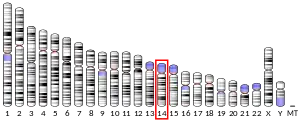ZFYVE26
Zinc finger, FYVE domain containing 26 is a protein that in humans is encoded by the ZFYVE26 gene.[5]
Function
This gene encodes a protein which contains a FYVE zinc finger binding domain. The presence of this domain is thought to target these proteins to Membrane lipids through interaction with Phospholipids in the membrane. Mutations in this gene are associated with autosomal recessive spastic paraplegia-15.[5]
References
- GRCh38: Ensembl release 89: ENSG00000072121 - Ensembl, May 2017
- GRCm38: Ensembl release 89: ENSMUSG00000066440 - Ensembl, May 2017
- "Human PubMed Reference:". National Center for Biotechnology Information, U.S. National Library of Medicine.
- "Mouse PubMed Reference:". National Center for Biotechnology Information, U.S. National Library of Medicine.
- "Entrez Gene: Zinc finger, FYVE domain containing 26".
Further reading
- Elleuch N, Bouslam N, Hanein S, Lossos A, Hamri A, Klebe S, Meiner V, Birouk N, Lerer I, Grid D, Bacq D, Tazir M, Zelenika D, Argov Z, Durr A, Yahyaoui M, Benomar A, Brice A, Stevanin G (Nov 2007). "Refinement of the SPG15 candidate interval and phenotypic heterogeneity in three large Arab families". Neurogenetics. 8 (4): 307–15. doi:10.1007/s10048-007-0097-x. PMID 17661097.
- Boukhris A, Stevanin G, Feki I, Denis E, Elleuch N, Miladi MI, Truchetto J, Denora P, Belal S, Mhiri C, Brice A (Mar 2008). "Hereditary spastic paraplegia with mental impairment and thin corpus callosum in Tunisia: SPG11, SPG15, and further genetic heterogeneity". Archives of Neurology. 65 (3): 393–402. doi:10.1001/archneur.65.3.393. PMID 18332254.
- Sagona AP, Nezis IP, Bache KG, Haglund K, Bakken AC, Skotheim RI, Stenmark H (2011). "A tumor-associated mutation of FYVE-CENT prevents its interaction with Beclin 1 and interferes with cytokinesis". PLOS ONE. 6 (3): e17086. doi:10.1371/journal.pone.0017086. PMC 3063775. PMID 21455500.
- Goizet C, Boukhris A, Maltete D, Guyant-Maréchal L, Truchetto J, Mundwiller E, Hanein S, Jonveaux P, Roelens F, Loureiro J, Godet E, Forlani S, Melki J, Auer-Grumbach M, Fernandez JC, Martin-Hardy P, Sibon I, Sole G, Orignac I, Mhiri C, Coutinho P, Durr A, Brice A, Stevanin G (Oct 2009). "SPG15 is the second most common cause of hereditary spastic paraplegia with thin corpus callosum". Neurology. 73 (14): 1111–9. doi:10.1212/WNL.0b013e3181bacf59. PMID 19805727.
- Sagona AP, Nezis IP, Pedersen NM, Liestøl K, Poulton J, Rusten TE, Skotheim RI, Raiborg C, Stenmark H (Apr 2010). "PtdIns(3)P controls cytokinesis through KIF13A-mediated recruitment of FYVE-CENT to the midbody" (PDF). Nature Cell Biology. 12 (4): 362–71. doi:10.1038/ncb2036. PMID 20208530.
- Schüle R, Schlipf N, Synofzik M, Klebe S, Klimpe S, Hehr U, Winner B, Lindig T, Dotzer A, Riess O, Winkler J, Schöls L, Bauer P (Dec 2009). "Frequency and phenotype of SPG11 and SPG15 in complicated hereditary spastic paraplegia". Journal of Neurology, Neurosurgery, and Psychiatry. 80 (12): 1402–4. doi:10.1136/jnnp.2008.167528. PMID 19917823.
- Murmu RP, Martin E, Rastetter A, Esteves T, Muriel MP, El Hachimi KH, Denora PS, Dauphin A, Fernandez JC, Duyckaerts C, Brice A, Darios F, Stevanin G (Jul 2011). "Cellular distribution and subcellular localization of spatacsin and spastizin, two proteins involved in hereditary spastic paraplegia". Molecular and Cellular Neurosciences. 47 (3): 191–202. doi:10.1016/j.mcn.2011.04.004. PMID 21545838.
- Hanein S, Martin E, Boukhris A, Byrne P, Goizet C, Hamri A, Benomar A, Lossos A, Denora P, Fernandez J, Elleuch N, Forlani S, Durr A, Feki I, Hutchinson M, Santorelli FM, Mhiri C, Brice A, Stevanin G (Apr 2008). "Identification of the SPG15 gene, encoding spastizin, as a frequent cause of complicated autosomal-recessive spastic paraplegia, including Kjellin syndrome". American Journal of Human Genetics. 82 (4): 992–1002. doi:10.1016/j.ajhg.2008.03.004. PMC 2427184. PMID 18394578.
- Hughes CA, Byrne PC, Webb S, McMonagle P, Patterson V, Hutchinson M, Parfrey NA (May 2001). "SPG15, a new locus for autosomal recessive complicated HSP on chromosome 14q". Neurology. 56 (9): 1230–3. doi:10.1212/wnl.56.9.1230. PMID 11342696.
This article incorporates text from the United States National Library of Medicine, which is in the public domain.
This article is issued from Wikipedia. The text is licensed under Creative Commons - Attribution - Sharealike. Additional terms may apply for the media files.



